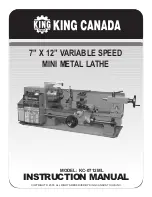
If the bed is too loose however, the weight
of the Tailstock and Tool rest base may
cause the bed to rotate. In this event, nip
`up the Bed Securing Set Screw (T, fig 10).
4.3 For additional rigidity of the motor and it’s
mounting brackets, a 8mm hole must be
drilled through the bench top using the hole
in the hinge bracket (V, fig 10), as a pilot. It
will be necessary to remove the four
mounting bolts and moving the headstock
slightly to facilitate the drilling of the hole.
Locate 1/4" x 3 1/2” long hex. head bolt in
the bag of loose parts together with 2 plain
flat washers, a spring lock washer and a nut.
Place a plain flat washer on to the bolt and
insert the bolt through the hinge bracket
hole and on through the bench top. From
the underside of the bench, place a plain
flat washer, the spring lock washer and then
the nut, on to the bolt. Do not tighten fully.
4.4 Next, secure the belt guard to the bench
with wood screws. Open the blade guard
cover to reveal three holes in the bottom
flange of the plate. Locate three 1/2 inch
long pan head wood screws in the bag of
loose parts. Ensure the plate is parallel to the
belt and the cover opens and closes easily
then screw in the wood screws loosely.
4.5 Gently shake the complete assembly to
ensure it is stable and lying flat on the bench,
and when satisfied, tighten the four
mounting bolts followed by the motor
bracket securing bolt and the three wood
screws, fully.
5.
COMPLETING THE ASSEMBLY
The 4 locking handles are used to lock the
Tailstock and the Tool Rest base to the bed, the
Tool Rest to its bracket, and to lock the Tailstock
spindle to prevent it from moving during
operation.
Before screwing the handles in place, ensure
that a brass slug is inserted in each of the holes
where the Tailstock and the Tool Rest base are
secured to the bed. i.e. the threaded hole
shown in the tool rest base in Fig. 4, and the
tailstock locking handle hole. (see fig. 6).
Finally, place the tool rest bracket on top of the
tool rest base and screw the bolt with flat washer
and wrench (as arranged in fig 5), through the
slot in the bracket and into one of the holes in
the base.
9
Fig. 5
The wrench provides a quick release type of
attachment, so that the tool rest can be moved
quickly to a new position. eg. As the diameter
of the workpiece decreases, the tool rest must
be moved to maintain an acceptable
clearance between it and the work. (This
adjustment MUST be carried out with the
machine switched OFF)
6.
ADJUSTING THE TAIL STOCK TO THE BED
The tailstock supports the workpiece for spindle
turning, that is, turning between centres.
To prevent it from rocking during operation a
screw is provided at its base (see fig. 6), which
bears against the keyway on the underside of
the bed, thereby reducing the play between
the key and the tailstock keyway.
To carry out this adjustment, proceed as follows
Tighten down the adjusting screw moderately
against the keyway, then slacken off about 1/4
turn.
Slide the tailstock along the full length of the bed.
If it binds or sticks in any one spot, loosen the
adjusting screw only enough so that the tail stock
slides smoothly. If the tail stock feels loose and
can be rocked slightly, tighten the screw only
enough so that it will not bind when sliding the
full length of the bed.
When both conditions have been met, tighten
the lock nut.
Fig. 6






























